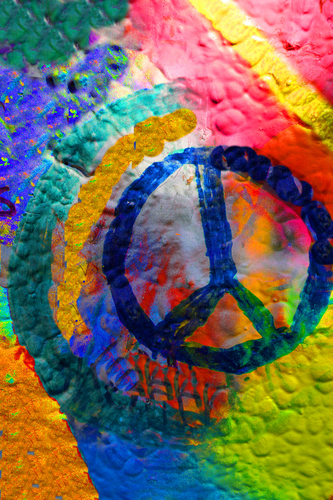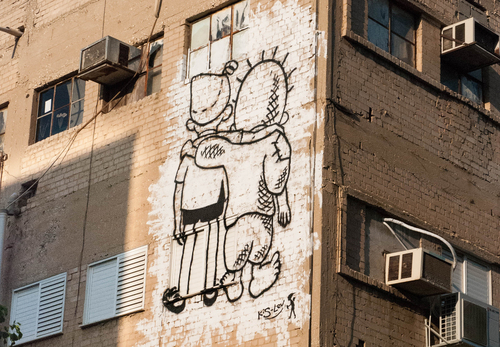As I began penning this initial issue of Art Education, I encountered a striking historical moment with the bleak picture of our future. Amid the Ukraine–Russia war, another tragic war in Israel and Palestine has also occupied the media. Watching this reality of destruction mediated through news reports from a geographically distant place led to an initial question: Is it real?
Unlike Baudrillard’s (Citation1994) media simulacra theorized on the basis of the Gulf War to stress the media construction of being real without reality, we are now witnessing the excruciating reality of wars that are filled with extremely turbulent moments—horror, fear, rage, and mourning reverberating through the bombed and fallen buildings among the piles of dead bodies. It is total dehumanization beyond our imagination. In this disheartening hyper-affective circumstance of genocide, I question whose bodies will be disposed and which affective stories will go unnoticed or raised, and for what purpose? The ultra-complex weave of governments’ ideological conflicts, desire for the occupation of land, military brutality, and media coverage all swallow up civilians’ desperate utterances for life, hope, peace, and safety—particularly for children. Such a hyper-power matrix violently silences children and youth to death, but also mercilessly undermines and obliterates the space in children’s lives where they can eat, play, learn, live safely, and in peace. Where is a human’s right and a child’s right in particular? Where is humanity?
This outrageously tumultuous time of dehumanization led me to ask: What should art education be like for social justice and the humanity of peace against war? What are we learning from this war? What ways can art education provide an anti-dehumanizing education for global peace to teachers? What ways can art education provide for children, refugees, and their rights? These questions can help educational communities to embark on a journey for peace, freedom, and human rights.
Teaching peace is an urgent need in the K–16 art educational space. In peace education through art, we first ask what is art education’s role and how can art education offer and ensure sustainable development during and after war? In the context of war, the restriction of human rights calls for development of new forms of social and educational adapted to the circumstance, optimizing living conditions considering the interests of civilians and refugees during and after the war.
Teaching and learning on peace does not contribute to the silence of what is happening, nor does it flatten and disapprove of dissent and differences. As critical pedagogy scholar Antonia Darder (Citation2009) points out, terror disrupts students’ critical power to imagine a different world. As stated by her, “imagining justice requires an ability to rethink the world a new” (p. 163) in which dissent plays an indispensable role. Further, dissent is essential for democratic principles in a diverse context, particularly in the face of a culture of terror. Imagining justice through dissensus can be a pedagogical orientation to pursue peace. Teaching peace therefore allows and encourages students’ dissenting voices, not in an indiscriminately antagonist way, and highlights untouched inequities. It reminds me that politics often disapproves of dissent, ignores antiwar voices and concerns, and justifies and defends the violence of war for national security concerns. Imagination of peace is important for an action toward peace. Imaginative, yet actionable, peace necessitates students’ critical examination of the conditions of injustice and inequity and offers a space to seek solutions through collaboration and consensus that arise from critical dissent. Rather than avoidance, opening dialogue that allows critical dissent is strongly encouraged to engage “the complexity of both human relations and human existence” (p. 164).
Marko Kafé, CC BY-SA 4.0 <https://creativecommons.org/licenses/by-sa/4.0>, via Wikimedia Commons.

The act of teaching and learning peace also importantly requires the promotion of critical compassion and empathy toward those who experience social and political turmoil and conflicts. Emotions are rarely regarded as constitutive elements in teaching practice. Because teaching peace must involve controversial issues in art classrooms, addressing such events unavoidably raises questions about the place of emotions in classroom dynamics. Thus, teaching peace suggests an imperative need to enhance students’ competence in the historical narrative at an emotional level in addition to the conscious level (Bekerman & Zembylas, Citation2011). When facing and dealing with conflicting historical moments, art teachers encounter the reality that students’ emotional responses are unavoidable in the classroom. Placing emotions in classroom dynamics when dealing with historical conflicts necessarily raises questions about who and in what way we define and justify (de)legitimate emotions and foreground invaluable feelings and desires (Bekerman & Zembylas, Citation2011). Rather than viewing adult teachers as the center of defining and justifying emotions, teaching peace in art as it pertains to diversity and social equity must acknowledge students’ multiple views and emotions while critically examining the realm of asymmetrical positions of power and ideologies.
Graffiti by Yuval Caspi (2020) in Kiryat HaMelaha Tel Aviv. Based on two famous national cartoons: Srulik of Kariel Gardosh who represents Israel and Handala by Naji al-Ali who represents the Palestinian people. CC BY 4.0 <https://creativecommons.org/licenses/by/4.0>, via Wikimedia Commons.

With such an approach to teaching peace, it is essential for art teachers and students to seek an understanding of how people experienced, or are experiencing, historical turmoil and war in order to develop compassion and empathy as emotional responses to others’ trauma or suffering. It is important to help students to develop a sense of otherness, but not as an individual sentimental reaction. To build this empathy, students must first contextualize the historical events by expanding their own perspectives. In this process, multicultural feminist scholar Sara Ahmed (Citation2004) teaches us how our thinking has been informed by our contact with an emotional event. Her idea of “sociality of emotion” suggests that feelings exist, move, and circulate in a crowd so that they open and connect bodies to other bodies. Compassion and empathy are evoked through such a collective mode and produce the “transformation of others into objects of feelings” (p. 11) that binds together a whole community for “radical solidarity” (Darder, Citation2009, p. 165) among students and teachers.
This pressing historical moment has irresistibly led me to urgently think of peace and art education for this editorial, but it does not directly correlate to the content of this issue. However, such an urgent demand for thinking about humanity and peace cannot be separated from equity-oriented art educational approaches to democracy that the authors in this issue attempt to share in nuanced ways.
The first article, by Shannon Thacker Cregg and Dana Carlisle Ketchka, Making Together, Learning Together: Social Connection, Collaboration, and Disability at the Columbus Museum of Art introduces their action research and practice in how art museums can create inclusive professional development programming for community artists and visitors with disabilities. Particularly, in examining the relations of three different sites and phenomena—art museums, art centers, and outsider art—the authors highlight an equitable collaborative artmaking workshop as a nonoppressive pedagogical approach to inclusive museum practice that supports the agency and voices of artists with disabilities and the social connection between art museums and community artists with disabilities. Their findings inform a collaborative museum programming that honors the disability identity in museum settings, integrates rather than segregates with art center and artists with disabilities, and disrupts negative labeling of outsider art known as art with disability.
The second article, In Dialogue: Initial Steps Toward Inquiry, Meaning-Making, and Democracy authored by Heather Kaplan, introduces constructivist dialogic, inquiry-based art curriculum building as hermeneutic practice to advance democratic citizenship and educational practices for collaborative programming between a university art museum and preservice teachers in an art education program. Japanese artist Gaku Tsutaja’s art practice as an exemplary case opens a space of dialogue that involves diverse, conflicting ways and process of seeing and thinking that lead to art creation for Family Day activities.
The third article, Art and Crisis: Preservice Teachers’ Coping Amid Constantly Changing Landscapes by J. Scott Baker, Daniel Gebur, Jessica Sester, Jamie Smith, and Whitney Yambrick, explores the importance of artmaking for preservice teachers’ positive construction of teacher identity during the multiple crises of COVID-19, systemic racism, and economic downturns. The preservice teachers’ narratives on their own art experiences highlight that artmaking through their reflection on past and present realities help their emotional needs and advance critical inquiry on the social, cultural, political, and economic impact on their lives and the schools when processing and coping the multiple challenges of ensuring the sustainable future of being a teacher.
Next, the article Five Educators, Three Issues, and the Innumerable Possibilities of Teaching Data Visualization in Art by Joy G. Bertling, Chris Grodoski, Amanda Gailbraith, Ericka Ryba, and Lynn Hodge, presents their reflection on pedagogical challenges and opportunities in their experiences of teaching data visualization within the K–12 art curriculum. Viewing empirical information as valid data for students’ exploration in the classroom and data visualization through divergent and generative art practices, the authors shared pedagogical considerations when using existing data or collecting new data, using single statistics or data sets, and creating artistic responses to data and data visualizations.
Last, Heather Heckel’s article Leadership Skills and Teaching Creativity Through Art Education examines how teaching creativity can impact leadership skills using quantitative methods to survey the superintendents of New York State school districts and New York City Department of Education arts education liaisons, as well as art teachers. The study aims to demonstrate the importance of artistic and creative teaching as necessary for all course development in addition to professional development. It examines the impact of teachers’ self-efficacy, societal value, and student potential, as well as environmental encouragement on teaching experience and creativity. The study’s finding emphasizes the importance of environmental encouragement on creative leadership for advancing policy making and leadership, which encourages continuous support for professional development, interdisciplinary connection, and collaboration with communities.
The instructional resource, titled Empowering ʹÔltәrs and the Work of Renée Stout written by Amber Ward, introduces a culturally competent learning and teaching particularly focused on Renée Stout’s work in relation to the idea of the African diaspora and border for secondary art educators. A workshop with a gallery tour of Renée Stout’s artwork and a studio investigation offers a space for student reflection on the topic of empowerment for collective consciousness.
References
- Ahmed, S. (2004). The cultural politics of emotion. Edinburgh University Press.
- Baudrillard, J. (1994). Simulacra and simulation (S. F. Claser, Trans.). University of Michigan Press.
- Bekerman, Z., & Zembylas, M. (2011). The emotional complexities of teaching conflictual historical narratives: The case of integrated Palestinian-Jewish schools in Israel. Teachers College Record, 113(5), 1004–1030.
- Darder, A. (2009). Imagining justice in a culture of terror: Pedagogy, politics, and dissent. In S. L. Macrine (Ed.), Critical pedagogy in uncertain times: Hope and possibilities (pp. 151–166). Palgrave Macmillan.
